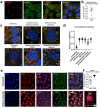This is a preprint.
Visualizing liquid-liquid phase transitions
- PMID: 39554013
- PMCID: PMC11565804
- DOI: 10.1101/2023.10.09.561572
Visualizing liquid-liquid phase transitions
Abstract
Liquid-liquid phase condensation governs a wide range of protein-protein and protein-RNA interactions in vivo and drives the formation of membrane-less compartments such as the nucleolus and stress granules. We have a broad overview of the importance of multivalency and protein disorder in driving liquid-liquid phase transitions. However, the large and complex nature of key proteins and RNA components involved in forming condensates such as stress granules has inhibited a detailed understanding of how condensates form and the structural interactions that take place within them. In this work, we focused on the small human SERF2 protein. We show here that SERF2 contributes to the formation of stress granules. We also show that SERF2 specifically interacts with non-canonical tetrahelical RNA structures called G-quadruplexes, structures which have previously been linked to stress granule formation. The excellent biophysical amenability of both SERF2 and RNA G4 quadruplexes has allowed us to obtain a high-resolution visualization of the multivalent protein-RNA interactions involved in liquid-liquid phase transitions. Our visualization has enabled us to characterize the role that protein disorder plays in these transitions, identify the specific contacts involved, and describe how these interactions impact the structural dynamics of the components involved in liquid-liquid phase transitions, thus enabling a detailed understanding of the structural transitions involved in early stages of ribonucleoprotein condensate formation.
Figures






Similar articles
-
Phase separation and pathologic transitions of RNP condensates in neurons: implications for amyotrophic lateral sclerosis, frontotemporal dementia and other neurodegenerative disorders.Front Mol Neurosci. 2023 Sep 1;16:1242925. doi: 10.3389/fnmol.2023.1242925. eCollection 2023. Front Mol Neurosci. 2023. PMID: 37720552 Free PMC article. Review.
-
The liquid nucleome - phase transitions in the nucleus at a glance.J Cell Sci. 2019 Nov 21;132(22):jcs235093. doi: 10.1242/jcs.235093. J Cell Sci. 2019. PMID: 31754043 Free PMC article. Review.
-
Friend or foe-Post-translational modifications as regulators of phase separation and RNP granule dynamics.J Biol Chem. 2019 May 3;294(18):7137-7150. doi: 10.1074/jbc.TM118.001189. Epub 2018 Dec 26. J Biol Chem. 2019. PMID: 30587571 Free PMC article. Review.
-
Determination of Protein Phase Diagrams by Centrifugation.Methods Mol Biol. 2020;2141:685-702. doi: 10.1007/978-1-0716-0524-0_35. Methods Mol Biol. 2020. PMID: 32696384
-
In vivo reconstitution finds multivalent RNA-RNA interactions as drivers of mesh-like condensates.Elife. 2021 Mar 2;10:e64252. doi: 10.7554/eLife.64252. Elife. 2021. PMID: 33650968 Free PMC article.
References
Publication types
Grants and funding
LinkOut - more resources
Full Text Sources
